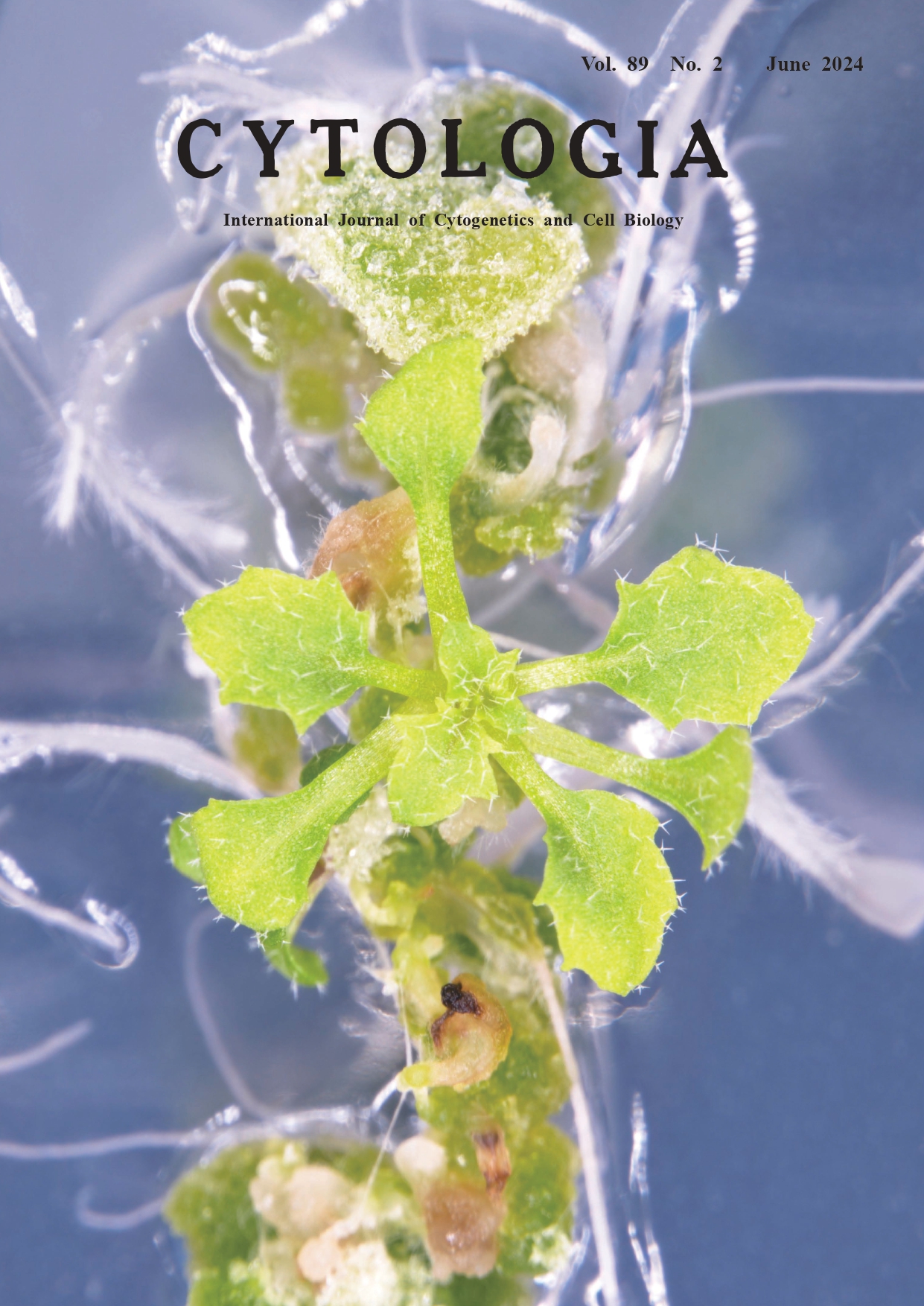| ON THE COVER |  |
||
|---|---|---|---|
| Vol. 89 No.2 June 2024 | |||
| Technical Note | |||
|
|
|||
Application of de novo shoot regeneration system from root explants of Arabidopsis thaliana Min Li, Hikaru Sato, and Sachihiro Matsunaga* Department of Integrated Biosciences, Graduate School of Frontier Sciences, The University of Tokyo, 5–1–5 Kashiwanoha, Kashiwa, Chiba 277–8562, Japan
Plants, unlike most animals, display extraordinary regenerative capacity to survive severe natural conditions. This highlights the biological significance of de novo shoot regeneration technique, crucial for both fundamental plant science and plant biotechnology. This technique is based on the characteristic of plant regeneration, comprising a two-step process of pluripotency acquisition and de novo shoot organogenesis (Sugimoto et al. 2019). In the initial step, root explants are cultured on auxinrich callus-inducing medium (CIM) to induce the formation of pluripotent callus. Subsequently, after acquiring the competence for organogenesis, the pluripotent callus is transferred onto cytokinin-rich shoot-inducing medium (SIM) to induce de novo shoot formation. The cover figure depicts a representative phenotypic image of shoot regeneration in wild type Arabidopsis thaliana (Col-0, Columbia). To evaluate the regenerative capacity, a technical system for de novo shoot regeneration was established. After sterilization, the seeds were sown onto MGRL medium containing 1.75 mM sodium phosphate buffer (pH 5.8), 1.5 mM MgSO4, 2.0 mM Ca(NO3)2, 3.0 mM KNO3, 67 μM Na2EDTA, 8.6 μM FeSO4, 10.3 μM MnSO4, 30 μM H3BO3, 1.0 μM ZnSO4, 24 nM (NH4)6Mo7O24, 130 nM CoCl12, 1 μM CuSO4, 15 g L-1 sucrose (Sigma), and 15 g L-1 gellan gum (Wako). After stratification for 2 days in darkness at 4°C, the plates were set up vertically in a growth chamber, and the plants were grown at 22°C for 6 days under a 16-h light/8-h dark photoperiod with a light intensity of 15 μmo m-2 s-1. Next, root explants (1 cm from the root tip) were excised from seedlings after 6 days of germination. Afterwards, root explants were cultured on CIM containing Gamborg’s B5 salt mixture (Sigma) with 20 g L-1 glucose (Wako), 0.5 g L-1 MES (NACALAI TESQUE, INC.), 1 mL L-1 Gamborg’s vitamin solution (Sigma), 500 μg L-1 of 2,4-D (Sigma), 50 μg L-1 of kinetin (Sigma), and 8 g L-1 gellan gum (Wako). The pH was adjusted to 5.7 by adding 1.0 M KOH. Continuous light was used for callus induction with a light intensity of 15 μmol m-2 s-1 at 25°C. After culturing on CIM for 14 days, the explants were transferred onto SIM containing Gamborg’s B5 salt mixture (Sigma) with 10 g L-1 glucose (Wako), 0.5 g L-1 MES (NACALAI TESQUE, INC.), 1 mL L-1 Gamborg’s vitamin solution (Sigma), 2 μg mL-1 trans-zeatin (Tokyo Chemical Industry), 0.4 μg mL-1 indole- 3-butyric acid (Sigma), 1 μg mL-1 d-biotin (Sigma), and 8 g L--1 gellan gum (Wako). The pH was adjusted to 5.7 by adding 1.0 M KOH. Continuous light was used for shoot induction with a light intensity of 15 μmol m-2 s-1 at 25°C. Finally, after culturing on SIM for 14 days, the frequencies of shoots per explant were statistically evaluated by microscopy observation (Nikon SMZ18), counting a visible apical meristem surrounded by 3 or more leaves with trichomes as one shoot. In summary, the de novo shoot regeneration system holds significance for both fundamental research and plant biotechnology (Ishihara et al. 2019; Temman et al. 2023).
Sugimoto, K., Temman, H., Kadokura, S., and Matsunaga, S. 2019. Toregenerate or not to regenerate: Factors that drive plant regeneration. Curr. Opin. Plant Biol. 47: 138–150. Temman, H., Sakamoto, T., Ueda, M., Sugimoto, K., Migihashi, M., Yamamoto, K., Tsujimoto-Inui, Y., Sato, H., Shibuta, M. K., Nishino, N., Nakamura, T., Shimada, H., Taniguchi, Y. Y., Takeda, S., Aida, M., Suzuki, T., Seki, M., and Matsunaga, S. 2023. Histone deacetylation regulates de novo shoot regeneration. PNAS Nexus 2: pgad002. * Corresponding author, e-mail: sachi@edu.k.u-tokyo.ac.jp DOI: 10.1508/cytologia.89.83 |
|||